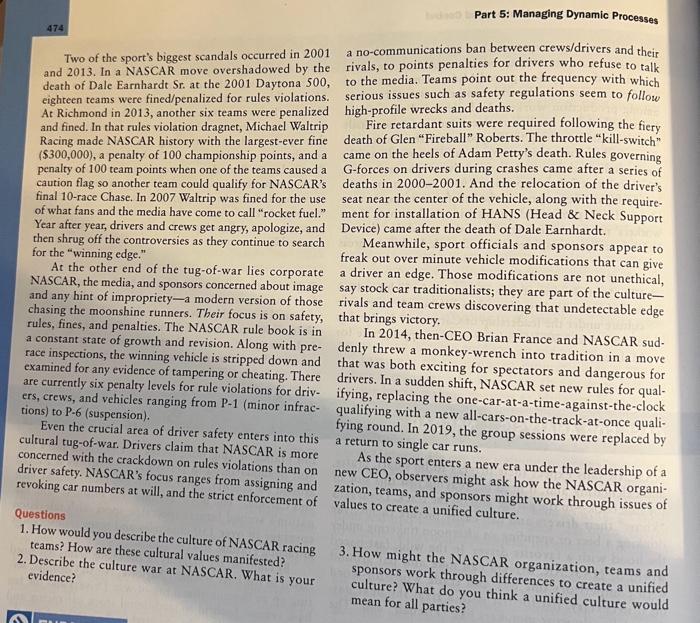Please answer the questions at the end of the case analysis and choose models from chapter Managing Dynamic Processes to resolve the issue.
NASCAR fans expect their drivers to be smart, crafty, and calculating and, if need be, playing iust this side of the rule book - in the garage and on the track. Loyal fans "know" their drivers and can easily picture themselves drinking a beer or spending an afternoon tinkering under the hood with a favorite driver. In the wild, fast-paced world of NASCAR, drivers can joke and pal around with competitors one day and trade word-for-word or, if necessary, fist-for-fist with a rival the next day. They defiantly wear monikers like "Fireball" and "The Intimidaror" And why not? The roots of the sport trace back to Prohubition when moonshine runners in souped-up cars raced actoss the hills of Appalachia oursmarting and outrunning the "Feds" and "Revenuers," taking risks with life and the law to make deliveries. As reputations grew, the desire for head-ro-head competition to establish bragging rights resulted in informal races. As the popularity of these races increased, one driver, Big. Bill France, gathered drivers and set up a meeting in Daytona in December 1947 to establish and standardize rulei for the many tracks scattered across the region. At that meeting, a new governing organization, the National Asinciarion for Stock Car Auto Racing (NASCAR) was born. Two months later, drivers met in the first NASCAR sanctioned race. Aeross decades, NASCAR has remained a "family business," Jim France, the son of NASCAR cofounder Bill France Sr. (Big Bill), serves as Chairman and CEO, Still headquartered in Daytona, with offices scattered around the country, NASCAR has expanded into Mexico and Canada. "The Boys" beeame "Big Business" and the nation's second largest spectator sport with television coverage in over 150 countries and team sponsorships attracting Fortune 500 companies. By contrast, the majority of the racing teams remained based in the hills around Charlotte, North Carolina, setting up an organizational tug-of-war. Drivers and the fan base remain faithful to traditional stock car racing and to the traditional tracks, devoted to the notion of "let the boys drive," including rule-breaking to gain an advantage. The outlaw image is cherished by NASCAR's fan base, as one sports columnist warned: "If the outlaw blood ever is completely drained, then NASCAR will be as colorless as the white flag that signals one lap to go. And its popularity could be just as fleeting." From the beginnings to recent history, it would appear there are few worries about the loss of that "outlaw image" and controversies are epic. In 1983, Richard Petty's Charlotte victory was allowed to "stand" despite over-thelimit engine cylinders. To the delight of fans, popular driver Junior Johnson continued the wild ways of his youth running moonshine for his dad, sneaking in illegal car modifications when he could, if it meant tearing down and rebuilding a car. He often got into trouble with NASCAR, but stock car traditionalists were thrilled. 474 Two of the sport's biggest scandals occurred in 2001 and 2013. In a NASCAR move overshadowed by the death of Dale Earnhardt Sr. at the 2001 Daytona 500 , eighteen teams were fined/penalized for rules violations. At Richmond in 2013, another six teams were penalized and fined. In that rules violation dragnet, Michael Waltrip Racing made NASCAR history with the largest-ever fine ($300,000), a penalty of 100 championship points, and a penalty of 100 team points when one of the teams caused a caution flag so another team could qualify for NASCAR's final 10-race Chase. In 2007 Waltrip was fined for the use of what fans and the media have come to call "rocket fuel." Year after year, drivers and crews get angry, apologize, and then shrug off the controversies as they continue to search for the "winning edge." At the other end of the tug-of-war lies corporate NASCAR, the media, and sponsors concerned about image and any hint of impropriety - a modern version of those chasing the moonshine runners. Their focus is on safety, rules, fines, and penalties. The NASCAR rule book is in a constant state of growth and revision. Along with prerace inspections, the winning vehicle is stripped down and examined for any evidence of tampering or cheating. There are currently six penalty levels for rule violations for drivers, crews, and vehicles ranging from P-1 (minor infractions) to P.6 (suspension). Even the crucial area of driver safety enters into this cultural tug-of-war. Drivers claim that NASCAR is more concerned with the crackdown on rules violations than on triver safety. NASCAR's focus ranges from assigning and evoking car numbers at will, and the strict enforcement of vestions 1. How would you describe the culture of NASCAR racing teams? How are these cultural values manifested? Describe the culture war at NASCAR. What is your evidence? a no-communications ban between crews/drivers and their rivals, to points penalties for drivers who refuse to talk to the media. Teams point out the frequency with which serious issues such as safety regulations seem to follow high-profile wrecks and deaths. Fire retardant suits were required following the fiery death of Glen "Fireball" Roberts. The throttle "kill-switch" came on the heels of Adam Petty's death. Rules governing G-forces on drivers during crashes came after a series of deaths in 2000-2001. And the relocation of the driver's seat near the center of the vehicle, along with the requirement for installation of HANS (Head \& Neck Support Device) came after the death of Dale Earnhardt. Meanwhile, sport officials and sponsors appear to freak out over minute vehicle modifications that can give a driver an edge. Those modifications are not unethical, say stock car traditionalists; they are part of the culturerivals and team crews discovering that undetectable edge that brings victory. In 2014, then-CEO Brian France and NASCAR sud. denly threw a monkey-wrench into tradition in a move that was both exciting for spectators and dangerous for drivers. In a sudden shift, NASCAR set new rules for qualifying, replacing the one-car-at-a-time-against-the-clock qualifying with a new all-cars-on-the-track-at-once qualifying round. In 2019, the group sessions were replaced by a return to single car runs. As the sport enters a new era under the leadership of a new CEO, observers might ask how the NASCAR organization, teams, and sponsors might work through issues of values to create a unified culture. 3. How might the NASCAR organization, teams and sponsors work through differences to create a unified culture? What do you think a unified culture would mean for all parties








